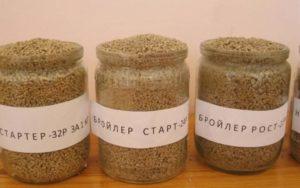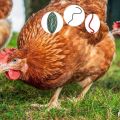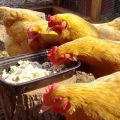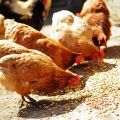How many grams of feed should a hen give per day
In order to achieve the maximum egg production of a particular breed of chickens, you need to clearly know how much feed you need to give a laying hen per day. Its growth and development, productivity, resistance to various diseases and unfavorable environmental factors depend on a properly composed diet, taking into account the age and physiological characteristics of the bird.
Feeding types for laying hens
Depending on the physical properties (moisture, flowability), the caloric content of the nutrient mixtures used, there are three types of feeding for laying hens: dry, wet and combined.
Dry
With this type of feeding, the basis of the diet of laying hens is made up of specialized dry crumbly compound feed for different ages. Consumption of compound feed per 1 adult laying hen at the same time ranges from 110-120 grams in summer, to 150-160 grams in the cold season.
Wet
With this type of feeding, the diet consists of such nutritional mixtures and feeds as:
- Wet mash of coarsely ground grains, crushed green grass, root crops. To add juiciness to the mash, in addition to juicy feed, they also add reverse broths prepared by boiling large bones.
- Juicy feed - various root crops (beets, potatoes, carrots), cabbage. In order to improve digestibility and reduce the risk of digestive problems in chickens, such feeds are pre-boiled or well chopped.
- Grain - barley, wheat, triticale. Approximately 2/3 of the grains are given to the poultry in dry form and only 1/3 in germinated form.
- Grain waste - cake, small grain.
The bulk of the nutrients with this type of feeding (about 40% of the daily requirement) is given in the form of wet mash 2 times a day.
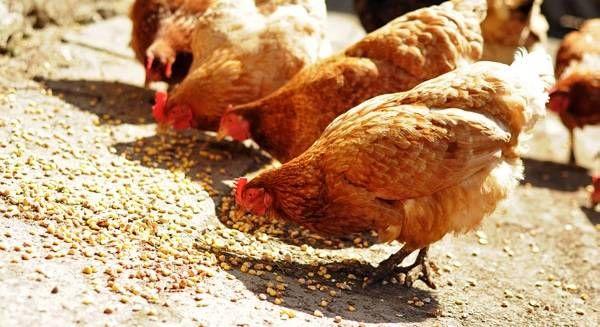
Combined
With the combined type of feeding, the daily ration of laying hens consists of 75% bulk compound feed and 25% wet mash. Compound feeds are fed throughout the day using automatic feeders. Wet mash is given to the bird 2 times a day, at strictly defined hours.
Laying hens' needs
For normal growth and development, laying hens need carbohydrates, proteins, fats, vitamins and minerals.
Carbohydrates
For normal growth and development, the carbohydrate content in feed should be 70-75% of their weight. The content of crude fiber with such a large amount of carbohydrates should not exceed 5-6%.

Protein
The need for proteins and amino acids in laying hens depends on their age:
- For chicks and young animals under 20 weeks of age, the crude protein content of the feed should be 17%;
- For adult birds aged 10 to 15 months, feed containing 16% crude protein is used.
- For hens over 15 months of age, feed with a protein content of not more than 14% is used.
Fats
The average fat content in feed for layers should be between 3-5%.
Vitamins
For full development and growth, hens need vitamins of two main groups:
- fat-soluble - A (retinol), D (calciferol), E (tocopherol);
- water-soluble - vitamins of group B (B1, B2, B3, B4, B5, B6, B12 Bc), H, C.
The bird's need for vitamins is replenished by adding special synthetic preparations to the feed.
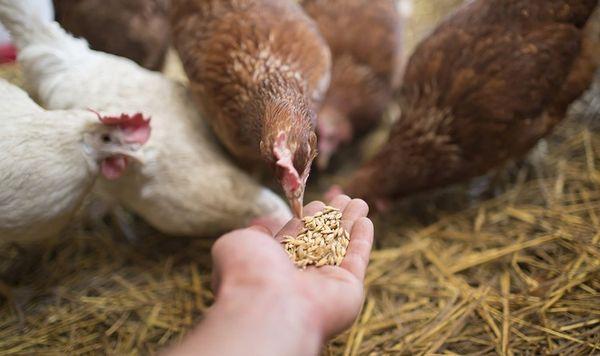
Minerals
Of the minerals, calcium and phosphorus are needed for the formation of large eggs with a strong shell. These elements are introduced into compound feed in the form of chalk, limestone, shell rock.
Calcium requirement per hen is calculated using the following formula:
- Ca = C x 2.251 x 0.5;
- where Ca is the need for calcium, gram / head;
- 2.251 - the amount of calcium in grams that is needed to get 1 egg;
- 0.5 is a correction factor.
Of the trace elements, poultry also needs manganese, zinc, copper, iron, cobalt, iodine, and selenium. They are introduced into compound feed in the form of special mineral additives.

How do nutritional norms depend on the age of the chicken?
In order for the feeding to be balanced, a correctly physiologically grounded calculation of the daily ration is necessary, taking into account the age of the bird.
For chickens
There are two age groups of chickens - from 1 to 7 weeks and from 8 to 20 weeks.
1-7 weeks
Chickens of this age are fed often (every 2 hours), but in small portions, which include barley and corn grits, low-fat cottage cheese, and the yolk of a hard-boiled egg. Also, from the first days, chickens begin to give green mass of alfalfa, clover or nettle. Daily feed consumption per chick in the first 5 days should not exceed 13-15 grams.
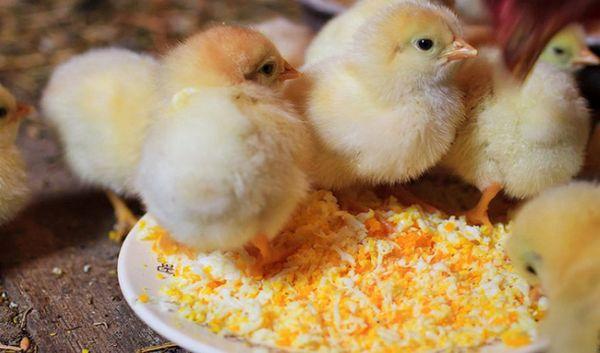
Up to 30 days of age, grain chickens are given only crushed and steamed. At the same time, despite the fact that one little laying hen at this age eats very little grain, the feed chopped in this way is an indispensable component of the chickens' diet.
Starting from a week of age, mineral supplements containing calcium and phosphorus are introduced into the diet - chalk, shells, shells.
8-20 weeks
From 8 weeks of age, the diet of chickens should consist of the following components:
- grain - 65 grams;
- millet - 10 grams;
- rye bran - 10 grams;
- hydrolytic yeast - 3.5 grams;
- flour from finely ground bones - 3.5 grams;
- lime materials - 1.5-2.0 grams;
- rock salt - 0.5 grams.
At this age, the chicken also eats well a wet mash of steamed and crushed grains, green mass, skim milk.
For adult chickens
In adult chickens, there are two age categories - 20-45 weeks and over 45 weeks.
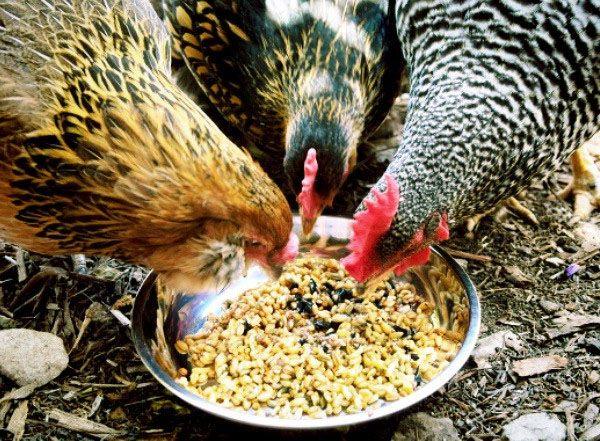
20-45 weeks
The daily feed intake for adult chickens in this age group is about 190 grams of feed per head. At the same time, the main part of the diet is crushed grain (about 60 grams), boiled potatoes - 50 grams. Also, be sure to add chalk, shell, yeast, bone meal, root vegetables to the feed.
After 45 weeks
For chickens over 45 weeks old, they leave the same diet as for the previous age category, increasing only the amount of grain and root crops by 10-15 grams.
How to give homemade food and how much you need per day
Nutritious compound feed can not only be purchased, but also made at minimal cost at home.
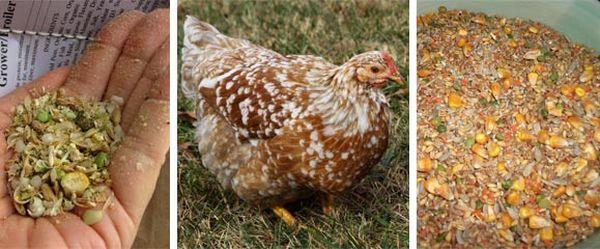
To prepare 1 kilogram of homemade balanced compound feed for layers, you must:
- 560 grams of crushed grain;
- 200 grams of millet;
- 100 grams of macuha;
- 100 grams of wheat bran;
- 40 grams of bone meal.
They give such homemade compound feed to adult layers 3-4 times a day, filling it with automatic feeders.
The consequences of overfeeding and malnutrition
Feeding hens should be balanced and normalized. Overfeeding, like underfeeding, has its own negative consequences for the bird.
So, an insufficient amount of feed leads to a decrease in the growth rate, the susceptibility of chickens and adult birds to various diseases, a significant decrease in egg production and the resistance of chickens to the effects of negative environmental factors.
Too much feeding, as a rule, leads to the accumulation of excess weight in the bird and a decrease in egg yield.

